Hybrid Fuzzy Multi-Criteria Analysis for Selecting Discrete Preferable Groundwater Recharge Sites
Abstract
1. Introduction
2. Case Study
- (1)
- Three main geological formations are presented: (a) the upper formation (8–80 m in thickness), of low permeability, consisting of clayey sand which interchanges at certain locations with gravel sand of little thickness, (b) the intermediate aquifer formation (10–70 in thickness), consisting of permeable gravel sand, considered as a shallow confined aquifer, in some locations changing to semi-confined aquifer, and (c) the lower impermeable formation consisting of clayey silt in depth of 30–90 m;
- (2)
- Transmissivity, T, ranges from 90 to 915 (m2/day), while the storage coefficient, S, ranges from 2.4 × 10−4 to 8.75 × 10−2;
- (3)
- The shallow aquifer system is naturally recharged, mainly from direct infiltration of precipitation and partially from percolation of the River Kosynthos (upstream zone of coarse-grained deposits);
- (4)
- The groundwater flow has a SE direction, being almost identical to that of the old riverbed’s direction in the area;
- (5)
- The groundwater main recharge axes appear to be in a S–SE direction towards Vistonida Lagoon;
- (6)
- The high quality of the water of the River Kosynthos gives rise to its use for artificial recharge purposes.
3. Materials and Methods
3.1. Criteria Description
- (1)
- Literature review and building of a detailed database including hydrogeological, morphological, etc., data;
- (2)
- The points with lithological profiles and hydraulic data of the aquifer and vadose zone were chosen for the application and development of the methodology. The other sites were eliminated;
- (3)
- Tensites were then chosen, of which 3 referred to confined aquifers, and for this reason they were excluded from the analysis;
- (4)
- The method was applied to the final chosen sites (7 in total) and the most suitable for MAR application was determined.
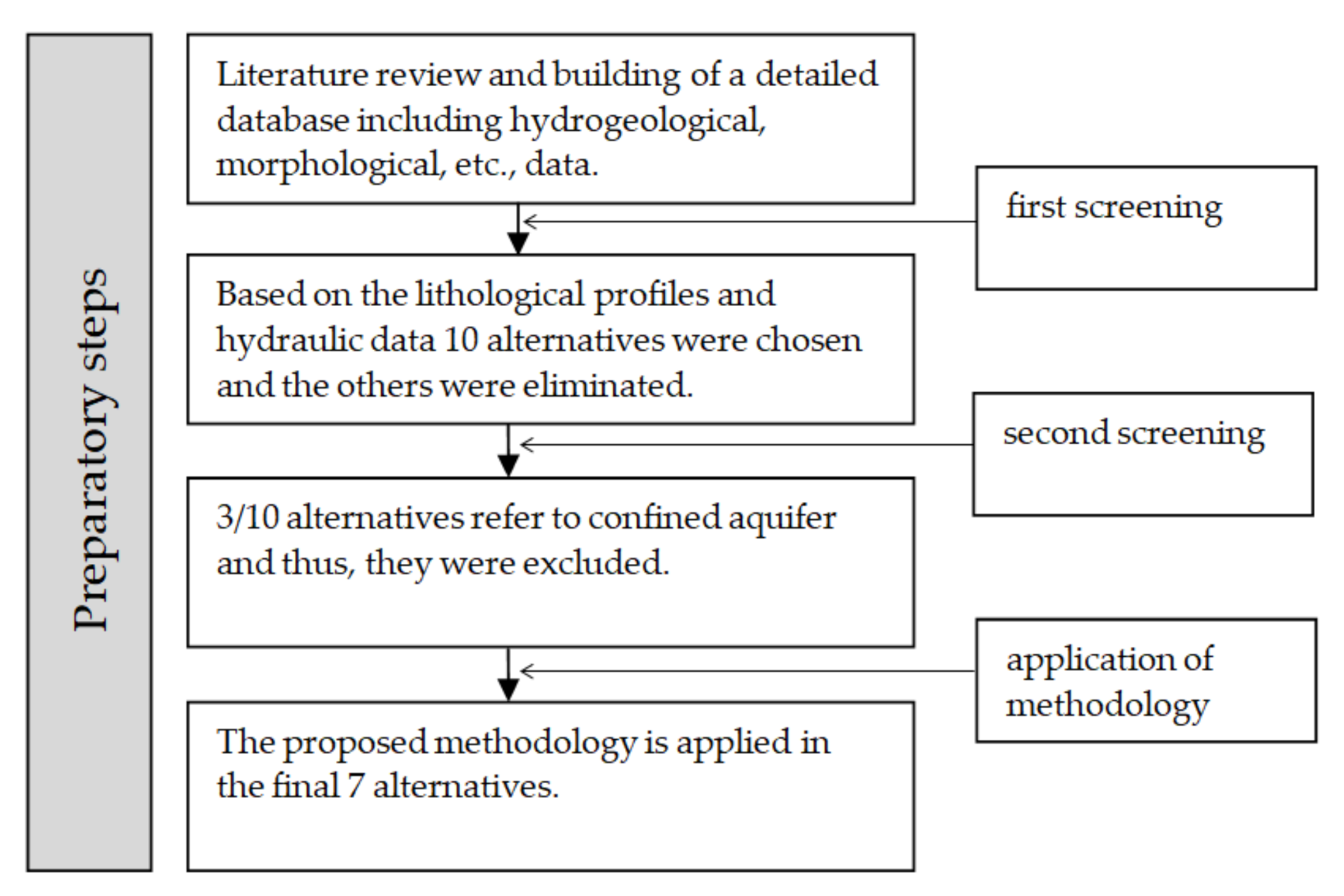
3.2. Fuzzy Analytic Hierarchy Process—FAHP
3.3. Fuzzy Inference Systems for the Evaluation of the Alternatives’ Rating
- (1)
- A fuzzifier. The degree to which the input data (the numeric value of the alternative with respect the examined criterion) satisfy the fuzzy rule is calculated. In this step, the classes of the input variables (criteria) are fuzzified.
- (2)
- An inference engine module. A series of fuzzy if–then rules is modulated. Based on the satisfaction degree described in the previous step and the selected fuzzy implication, the fuzzy rules fire strength to infer knowledge. Thus, a fuzzy conclusion is calculated for each rule.
- (3)
- Aggregation. All fuzzy conclusions inferred by all fuzzy rules are combined into a final fuzzy conclusion.
- (4)
- A defuzzifier. The fuzzy output (inferred knowledge) is translated to crisp output (rating of each alternative with respect to the examined criterion).
4. Implementation and Results
- (1)
- Based on the experts’ knowledge, a fuzzy reciprocal pairwise comparison matrix (Equation (2)) was generated regarding the examined (nine) criteria. Table 1 presents the elements of Saaty’s scale [70] as triangular fuzzy numbers (TFN) (Equation (6)), while the fuzzy judgments of the matrix are presented in Equation (24).
- (2)
- The optimization problem described in Equation (9) was built and solved by the use of the optimization software LINGO and the weights of criteria (priority vector) were estimated as crisp numbers. Then, the priority vector was normalized based on Equation (10). For space saving reasons, only an example of a pair of inequalities is given regarding the criteria of transmissivity (C5) and piezometry (C9). Based on Equation (24) presented below, transmissivity was considered moderate less important in comparison to piezometry; that is . Therefore, it holds:
- (3)
- A Mamdani fuzzy inference system, included in the Fuzzy Logic Toolbox of MATLAB, was designed for each criterion. Initially, based on the experts’ judgments, the classes of the examined criteria were fuzzified. The number of classes was determined by using the empirical rule of Sturges [92], which is a common technique in hydrology (Equation (22)):where q is the number of classes and N is the number of data (the numeric value of each alternative regarding the examined criterion, i.e., N = 7).
- (4)
- The rating (R) of each alternative was multiplied with the weight of the examined criterion. The final evaluation (final score) of each alternative with respect of all criteria was achieved based on an aggregative model described as follows:where is the alternative under consideration, is the weight of the criterion i (for n = 9) and is the estimated (by the corresponding FIS) rating of regarding the criterion i.
- (5)
- Based on Equation (23), a rank list of the alternatives (from the most suitable site to the least suitable site for applying MAR) was obtained by using both the algebraic product (Equation (19)) and min implication (Equation (20)) (Table 3). It is noted that although the M-value adopted in this study is equal to 0.5, the results based on M = 1 are also presented in Table 3.
| Relative Importance of Two Criteria | TFN |
|---|---|
| Equal | (0.5, 1, 1.5) |
| Moderate | (2, 3, 4) |
| Strong | (3.75, 5, 6.25) |
| Very strong | (5.5, 7, 8.5) |
| Extreme | (7, 9, 9) |
| Intermediate values | (1.25, 2, 2.75), (3, 4, 5), (4.75, 6, 7.25), (6.5, 8, 9) |
| Criteria | Classes | Linguistic Variable | Rating | Weight | Normalized Weight |
|---|---|---|---|---|---|
| C1 | High | 10 | 1.6641 | 0.0169 | |
| Good | 8 | ||||
| Moderate | 6 | ||||
| Deficient | 4 | ||||
| Worse | 2 | ||||
| Unknown | 0 | ||||
| C2 | 0–2 | High | 10 | 3.8704 | 0.0394 |
| 2–5 | Moderately high | 7.5 | |||
| 5–10 | Moderately low | 5 | |||
| >10 | Low | 2.5 | |||
| C3 | <1000 | High | 10 | 3.9769 | 0.0405 |
| 1000–2000 | Moderately high | 7.5 | |||
| 2000–3000 | Moderately low | 5 | |||
| >3000 | Low | 2.5 | |||
| C4 | 0–5000 | High | 10 | 4.0643 | 0.0414 |
| 5000–10,000 | Moderately high | 7.5 | |||
| 10,000–15,000 | Moderately low | 5 | |||
| >15,000 | Low | 2.5 | |||
| C5 | >1000 | High | 10 | 10.8694 | 0.1109 |
| 500–1000 | Moderately high | 7.5 | |||
| 250–500 | Moderately low | 5 | |||
| 0–250 | Low | 2.5 | |||
| C6 | >0.015 | High | 10 | 15.3198 | 0.1563 |
| 0.005–0.015 | Moderately high | 7.5 | |||
| 0.0025–0.005 | Moderately low | 5 | |||
| 0–0.0025 | Low | 2.5 | |||
| C7 | <−1 | High | 10 | 15.3198 | 0.1563 |
| −1–0 | Moderately high | 7.5 | |||
| 0–1 | Moderately low | 5 | |||
| >1 | Low | 2.5 | |||
| C8 | 1 | High | 10 | 21.1237 | 0.2155 |
| 0 | Low | 0 | |||
| C9 | 1 | High | 10 | 21.7949 | 0.2223 |
| 0 | Low | 0 |
| Ranking Order/ Implication | Alg. Prod. (M = 0.5) | Min (M = 0.5) | Alg. Prod. (M = 1) | Min (M = 1) |
|---|---|---|---|---|
| Al5 | 8.0317 | 8.0320 | 7.9846 | 7.9792 |
| Al2 | 7.9859 | 7.9932 | 7.9355 | 7.9370 |
| Al1 | 7.7936 | 7.7877 | 7.7329 | 7.7191 |
| Al4 | 7.3382 | 7.3611 | 7.2765 | 7.2939 |
| Al7 | 6.5145 | 6.5179 | 6.4232 | 6.4228 |
| Al6 | 4.6199 | 4.6045 | 4.5888 | 4.5712 |
| Al3 | 4.5822 | 4.5829 | 4.5508 | 4.7090 |
5. Discussion
6. Conclusions
- (1)
- The more preferable sites are located in the northwestern part of the study area near the Kosynthos River, while the most preferable is the Al5 alternative. This mainly holds due to the hydrological conditions of the northwestern part, which are more favorable than the southeastern ones for groundwater recharge. However, this is not an absolute condition due to the intense diversity of geological formations. In addition, the contribution of the analysis of the other criteria also affected the final rank list.
- (2)
- The proposed methodology can be used for distinguishing discrete preferable points (alternatives) for MAR application without limitation in number of the examined alternatives. In addition, the selected criteria can be added or subtracted depending on specific local conditions. In case of application of another type of MAR the selected criteria should be adjusted as well. Certainly, in the case of a small number (<10) of alternatives to study, a classical hydrogeological analysis may lead to the selection of the most preferable alternative. However, in that case, the criteria weights would not be taken into account and thus, there would be the possibility of not obtaining an efficient and comprehensive solution. On the other hand, in the case of a large number of examined alternatives and criteria, where the complexity increased, the proposed methodology might be also a useful tool for ranking discrete alternatives. Other than that, it could be used as an alternative way to identify suitable recharge sites in case of low data availability.
- (3)
- The applicability of the methodology requires lithological profile and hydraulic characteristics of both vadose and saturated zones, while it can be applied only in unconfined aquifers and where there is an underlying drainage axis. Furthermore, the application of this type of MAR requires the presence of a river whose excess waters can be utilized. Thus, after a preparatory screening, seven alternatives satisfied all the assumptions and criteria were finally evaluated.
- (4)
- In general, the use of fuzzy logic in AHP can incorporate the uncertainty from the subjectivity of the initial experts’ judgments, while the fuzzy version of AHP implemented in this paper (FAHP–LFFP-based nonlinear method) can ensure a unique and optimal solution.
- (5)
- Fuzzy inference systems (FIS) based on Mamdani’s approach are used in order to determine the rating of each alternative, since the objective function (or value function) regarding each examined criterion is unknown. In addition, with use of FIS, the classes of criteria are fuzzified, and this fact is more reasonable to describe the real conditions.
Author Contributions
Funding
Conflicts of Interest
Appendix A
- (1)
- is a normal set, i.e., such that ;
- (2)
- must be a closed interval ;
- (3)
- the strong zero cut, , which is called the support set of , must be bounded.
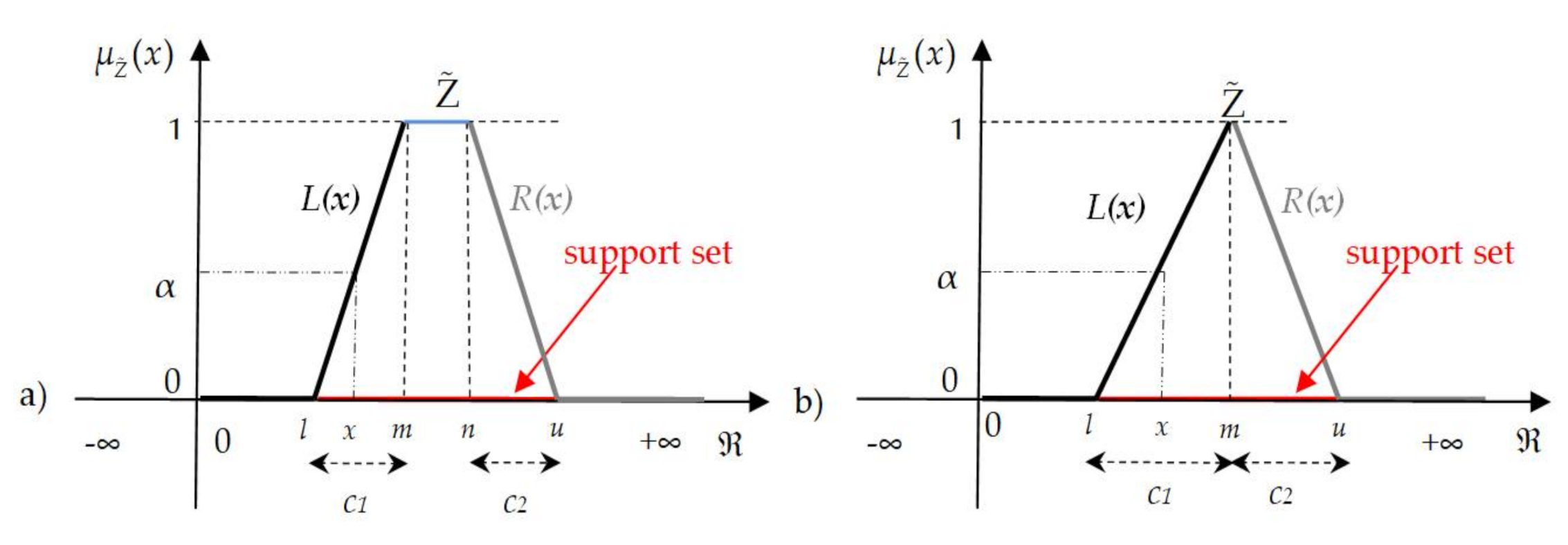
Appendix B
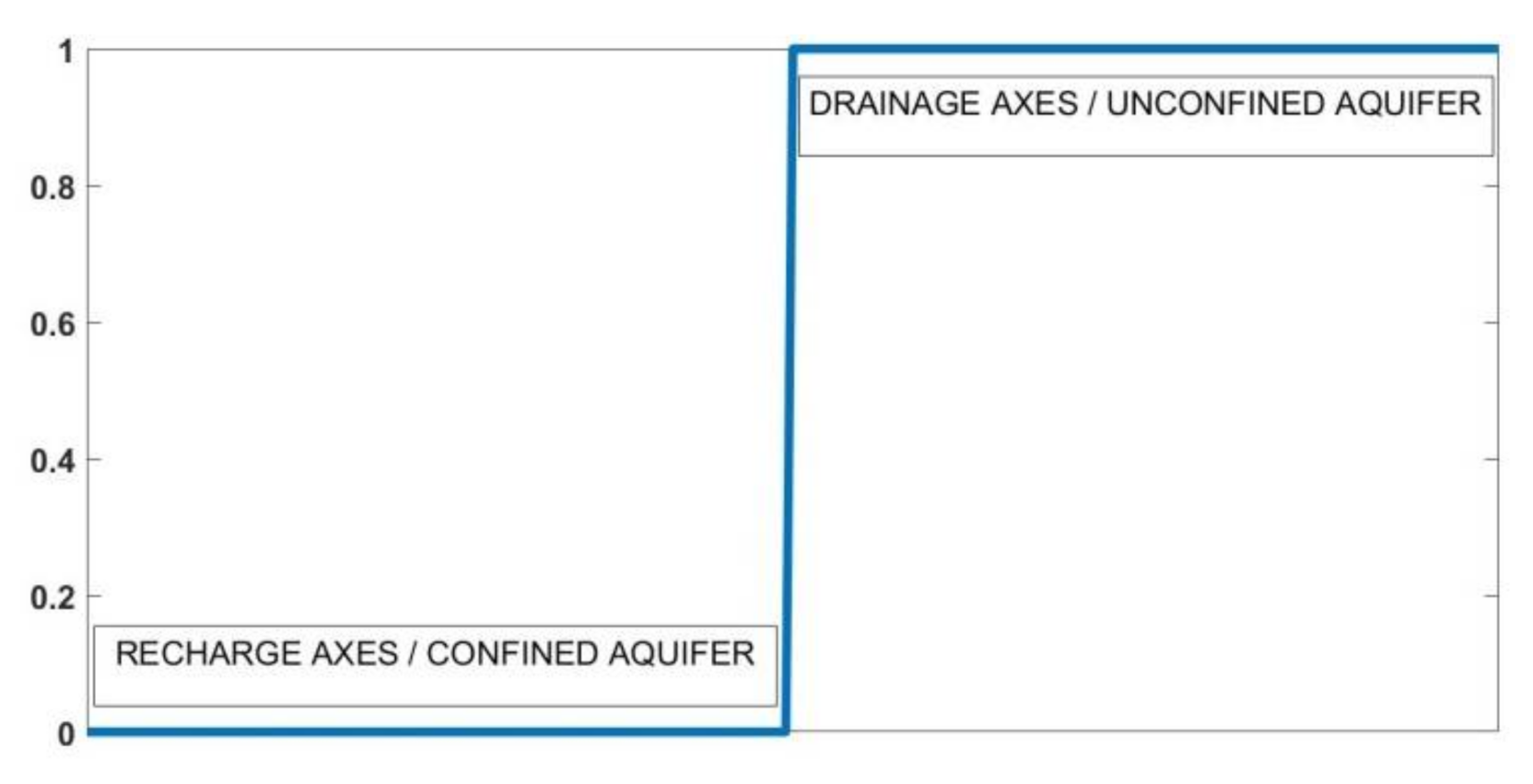
References
- Vörösmarty, C.J.; Green, P.; Salisbury, J.; Lammers, R.B. Global Water Resources: Vulnerability from Climate Change and Population Growth. Science 2000, 289, 284–288. [Google Scholar] [CrossRef]
- Tebaldi, C.; Hayhoe, K.; Arblaster, J.M.; Meehl, G.A. Going to the extremes. Clim. Chang. 2006, 79, 185–211. [Google Scholar] [CrossRef]
- Taylor, R.G.; Scanlon, B.; Döll, P.; Rodell, M.; Van Beek, R.; Wada, Y.; Longuevergne, L.; Leblanc, M.; Famiglietti, J.S.; Edmunds, M.; et al. Ground water and climate change. Nat. Clim. Chang. 2013, 3, 322–329. [Google Scholar] [CrossRef]
- Zwiers, F.W.; Alexander, L.V.; Hegerl, G.C.; Knutson, T.R.; Kossin, J.P.; Naveau, P.; Nicholls, N.; Schär, C.; Seneviratne, S.I.; Zhang, X. Climate extremes: Challenges in estimating and understanding recent changes in the frequency and intensity of extreme climate and weather events. In Climate Science for Serving Society; Asrar, G.R., Hurrell, J.W., Eds.; Springer: Dordrecht, The Netherlands, 2013; pp. 339–389. ISBN 978-94-007-6691-4. [Google Scholar]
- Wuebbles, D.; Meehl, G.; Hayhoe, K.; Karl, T.R.; Kunkel, K.; Santer, B.; Wehner, M.; Colle, B.; Fischer, E.M.; Fu, R.; et al. CMIP5Climate Model Analyses: Climate Extremes in the United States. Bull. Am. Meteor. Soc. 2013, 95, 571–583. [Google Scholar] [CrossRef]
- Bouwer, H. Artificial recharge of groundwater:hydrogeology and engineering. Hydrogeol. J. 2000, 10, 121–142. [Google Scholar]
- Maliva, R.G.; Guo, W.; Missimer, T.M. Aquifer storage and recovery: Recent hydrogeological advances and system performance. Water Environ. Res. 2006, 78, 2428–2435. [Google Scholar] [CrossRef]
- Jager, H.I.; Smith, B.T. Sustainable Reservoir Operation: Can We Generate Hydropower and Preserve Ecosystem Values? River Res. Appl. 2008, 24, 340–352. [Google Scholar] [CrossRef]
- Minsley, B.J.; Ajo-Franklin, J.; Mukhopadhyay, A.; Morgan, F.D. Hydrogeophysical Methods for Analyzing Aquifer Storage and Recovery Systems. Groundwater 2011, 49, 250–269. [Google Scholar] [CrossRef]
- Giordano, M. Global Groundwater? Issues and Solutions. Annu. Rev. Environ. Resour. 2009, 34, 153–178. [Google Scholar] [CrossRef]
- Kundzewicz, Z.W.; Doll, P. Will groundwater ease freshwater stress under climate change? Hydrol. Sci. J. 2009, 54, 665–675. [Google Scholar] [CrossRef]
- Scanlon, B.R.; Reedy, R.C.; Faunt, C.C.; Pool, D.; Uhlman, K. Enhancing drought resilience with conjunctive use and managed aquifer recharge in California and Arizona. Environ. Res. Lett. 2016, 11, 035013. [Google Scholar]
- de Graaf, I.E.M.; Gleeson, T.; Rens van Beek, L.P.H.; Sutanudjaja, E.H.; Bierkens, M.F.P. Environmental Flow Limits to Global Groundwater Pumping. Nature 2019, 574, 90–94. [Google Scholar] [CrossRef]
- Dillon, P. Future management of aquifer recharge. Hydrogeol. J. 2005, 13, 313–316. [Google Scholar] [CrossRef]
- Niswonger, R.G.; Morway, E.D.; Triana, E.; Huntington, J.L. Managed aquifer recharge through off-season irrigation in agricultural regions. Water Resour. Res. 2017, 53, 6970–6992. [Google Scholar] [CrossRef]
- California Department of Water Resources. Using Flood Water for Managed Aquifer Recharge to Support Sustainable Water Resources. White Paper. 26 June 2018, p. 54. Available online: https://ui.adsabs.harvard.edu/abs/2018AGUFM.H51X1679M/abstract (accessed on 30 December 2021).
- Dillon, P.; Stuyfzand, P.; Grischek, T.; Lluria, M.; Pyne, R.D.G.; Jain, R.C.; Bear, J.; Schwarz, J.; Wang, W.; Fernandez, E.; et al. Sixty years of global progress in managed aquifer recharge. Hydrogeol. J. 2019, 27, 1–30. [Google Scholar] [CrossRef]
- Wendt, D.E.; Van Loon, A.F.; Scanlon, B.R.; Hannah, D.M. Managed Aquifer Recharge as a Drought Mitigation Strategy in Heavily-Stressed Aquifers. Environ. Res. Lett. 2021, 16, 014046. [Google Scholar] [CrossRef]
- Zhao, M.; Boll, J.; Adam, J.C.; King, A.B. Can Managed Aquifer Recharge Overcome Multiple Droughts? Water 2021, 13, 2278. [Google Scholar] [CrossRef]
- Gale, I.N.; Dillon, P. Strategies for Managed Aquifer Recharge (MAR) in Semi-Arid Areas; United Nations Educational, Scientific and Cultural Organisation (UNESCO): Paris, France, 2005; p. 30. [Google Scholar]
- Ringleb, J.; Sallwey, J.; Stefan, C. Assessment of Managed Aquifer Recharge through Modeling—A Review. Water 2016, 8, 579. [Google Scholar] [CrossRef]
- Foster, S.; van Steenbergen, F. Conjunctive groundwater use: A ‘lost opportunity’ for water management in the developingworld? Hydrogeol. J. 2011, 19, 959–962. [Google Scholar] [CrossRef]
- Maliva, R.G. Antropogenic Aquifer Recharge; WSP Methods in Water Resources Evaluation Series No. 5; Springer: Cham, Switzerland, 2020; p. 861. [Google Scholar] [CrossRef]
- Dillon, P.; Escalante, E.F.; Tuinhof, A. Management of Aquifer Recharge and Discharge Processes and Aquifer Storage Equilibrium; Groundwater Governance Thematic Paper 4; GEF-FAO: Rome, Italy, 2012. [Google Scholar]
- Pakparvar, M.; Walraevens, K.; Cheraghi, S.A.M.; Cornelis, W.; Gabriels, D.; Kowsar, S.A. Assessment of groundwater recharge influenced by floodwater spreading: An intergrated approach with limited accessible data. Hydrol. Sci. J. 2017, 62, 147–164. [Google Scholar] [CrossRef]
- Hashemi, H.; Berndtsson, R.; Persson, M. Artificial recharge by floodwater spreading estimated by water balancesand groundwater modeling in arid Iran. Hydrol. Sci. J. 2015, 60, 336–350. [Google Scholar] [CrossRef]
- Saraf, A.K.; Choudhury, P.R. Integrated remote sensing and GIS for ground waterexploration and identification of artificial recharge sites. Int. J. Remote Sens. 1998, 19, 1825–1841. [Google Scholar] [CrossRef]
- Al Saud, M. Mapping potential areas for groundwater storage in Wadi Aurnah Basin, western Arabian Peninsula, using remote sensing and geographic information system techniques. Hydrogeol. J. 2010, 18, 1481–1495. [Google Scholar] [CrossRef]
- Senanayake, I.P.; Dissanayake, D.M.D.O.K.; Mayadunna, B.B.; Weerasekera, W.L. An approach to delineate groundwater recharge potential sites in Ambalantota, Sri Lanka using GIS techniques. Geosci. Front. 2016, 7, 115–124. [Google Scholar] [CrossRef]
- Chenini, I.; Ben Mammou, A.; El May, M. Groundwater Recharge Zone Mapping Using GIS-Based Multi-criteria Analysis: A Case Study in Central Tunisia (Maknassy Basin). Water Resour. Manag. 2010, 24, 921–939. [Google Scholar] [CrossRef]
- Chowdhury, A.; Jha, M.K.; Chowdary, V.M. Delineation of groundwater recharge zones and identification of artificial recharge sites in West Medinipur district, West Bengal, using RS, GIS and MCDM techniques. Environ. Earth Sci. 2010, 59, 1209–1222. [Google Scholar] [CrossRef]
- Nasiri, H.; DarvishiBoloorani, A.; FarajiSabokbar, H.A.; Jafari, H.R.; Hamzeh, M.; Rafi, Y. Determining the most suitable areas for artificial groundwater recharge via an integrated PROMETHEE II-AHP method in GIS environment (case study: Garabaygan Basin, Iran). Environ. Monit. Assess. 2013, 185, 707–718. [Google Scholar] [CrossRef]
- Valverde, J.P.B.; Blank, C.; Roidt, M.; Schneider, L.; Stefan, C. Application of a GIS Multi-Criteria Decision Analysis for the Identification of Intrinsic Suitable Sites in Costa Rica for the Application of Managed Aquifer Recharge (MAR) through Spreading Methods. Water 2016, 8, 391. [Google Scholar] [CrossRef]
- Selvarani, A.G.; Maheswaran, G.; Elangovan, K. Identification of artificial recharge sites for Noyyal River Basin using GIS and remote sensing. J. Indian Soc. Remote Sens. 2017, 45, 67–77. [Google Scholar] [CrossRef]
- Kazakis, N. Delineation of Suitable Zones for the Application of Managed Aquifer Recharge (MAR) in Coastal Aquifers Using Quantitative Parameters and the Analytical Hierarchy Process. Water 2018, 10, 804. [Google Scholar] [CrossRef]
- Zadeh, L.A. Fuzzy sets. Inf. Control 1965, 8, 338–353. [Google Scholar]
- Zimmermann, H.-J. Advanced Review. Fuzzy set theory. WIREs Comput. Stat. 2010, 2, 317–332. [Google Scholar] [CrossRef]
- Garg, H. A Hybrid GA-GSA Algorithm for Optimizing the Performance of an Industrial System by Utilizing Uncertain Data. In Handbook of Research on Artificial Intelligence Techniques and Algorithms; Pandian, V., Ed.; IGI Global: Hershey, PE, USA, 2015; pp. 620–654. [Google Scholar] [CrossRef]
- Bogardi, I.; Duckstein, L.; Bardossy, A. Regional management of an aquifer under fuzzy environmental objectives. Water Resour. Res. 1983, 19, 1394–1402. [Google Scholar] [CrossRef]
- Kambalimath, S.; Deka, P.C. A basic review of fuzzy logic applications in hydrology and water resources. Appl. Water Sci. 2020, 10, 191. [Google Scholar] [CrossRef]
- Kazakis, N.; Spiliotis, M.; Voudouris, K.; Pliakas, F.K.; Papadopoulos, B. A fuzzy multicriteria categorization of the GALDIT method to assess seawater intrusion vulnerability of coastal aquifers. Sci. Total Environ. 2018, 621, 524–534. [Google Scholar] [CrossRef]
- Kourgialas, N.N.; Anyfanti, I.; Karatzas, G.P.; Dokou, Z. An integrated method for assessing drought prone areas-Water efficiency practices for a climate resilient Mediterranean agriculture. Sci. Total Environ. 2018, 625, 1290–1300. [Google Scholar] [CrossRef]
- Spiliotis, M.; Iglesias, A.; Garrote, L. A multicriteria fuzzy pattern recognition approach for assessing the vulnerability to drought: Mediterranean region. Evol. Syst. 2021, 12, 109–122. [Google Scholar] [CrossRef]
- Chan, F.T.S.; Kumar, N. Global supplier development considering risk factors using fuzzy extended AHP-based approach. Omega 2007, 35, 417–431. [Google Scholar] [CrossRef]
- Chan, F.T.S.; Kumar, N.; Tiwari, M.K.; Lau, H.C.W.; Choy, K.L. Global supplier selection: A fuzzy-AHP approach. Int. J. Prod. Res. 2008, 46, 3825–3857. [Google Scholar] [CrossRef]
- Saravi, M.M.; Malekian, A.; Nouri, B. Identification of Suitable Sites for Groundwater Recharge. In Proceedings of the 2nd International Conference on Water Resources & Arid Environment, Riyadh, Saudi Arabia, 26–29 November 2006; pp. 1–5. [Google Scholar]
- Ghayoumian, J.; MohseniSaravi, M.; Feiznia, S.; Nouri, B.; Malekian, A. Application of GIS techniques to determine areas most suitable for artificial groundwater recharge in a coastal aquifer in southern Iran. J. Asian Earth Sci. 2007, 30, 364–374. [Google Scholar] [CrossRef]
- Riad, P.H.; Billib, M.H.; Hasan, A.A.; Omar, M.A. Overlay Weighted Model and Fuzzy Logic to Determine the Best Locations for Artificial Recharge of Groundwater in a Semi-Arid Area in Egypt. Nile Basin Water Sci. Eng. J. 2011, 4, 24–35. [Google Scholar]
- Malekmohammadi, B.; Mehrian, M.R.; Jafari, H.R. Site selection for managed aquifer recharge using fuzzy rules: Integrating geographical information system (GIS) tools and multi-criteria decision making. Hydrogeol. J. 2012, 20, 1393–1405. [Google Scholar] [CrossRef]
- Dashtpagerdi, M.M.; Vagharfard, H.; Honarbakhsh, A.; Khoorani, A. GIS Based Fuzzy Logic Approach for Identification of Groundwater Artificial Recharge Site. Open J. Geol. 2013, 3, 379–383. [Google Scholar] [CrossRef][Green Version]
- Selvarani, A.G.; Maheswaran, G.; Elangovan, K. Identification of Artificial Recharge Sites For Noyyal Watershed Using GIS And Fuzzy Logic. Int. J. Appl. Eng. Res. 2015, 10, 11189–11208. [Google Scholar]
- Ghasemi, A.; Saghafian, B.; Golian, S. Optimal location of artificial recharge of treated wastewater using fuzzy logic approach. J. Water Supply Res. Technol. 2017, 66, 141–156. [Google Scholar] [CrossRef]
- Pliakas, F.; Kallioras, A.; Damianidis, P.; Kostakakis, P. Evaluation of precipitation effects on groundwater levels in a Mediterranean alluvial plain based on hydrogeological conceptualization. Environ. Earth Sci. 2015, 74, 3573–3588. [Google Scholar] [CrossRef]
- Dimadis, E.; Zachos, S. Geological Map of Rhodope Massif; Institute of Geology and Mineral Exploration (IGME), Regional Subdivision of Eastern Macedonia—Thrace: Xanthi, Greece, 1986. [Google Scholar]
- Sakkas, I.; Diamantis, I.; Pliakas, F. Groundwater Artificial Recharge Study of Xanthi-Rhodope Aquifers (in Thrace, Greece); Greek Ministry of Agriculture Research Project, Final Report; Sections of Geotechnical Engineering and Hydraulics of the Civil Engineering Department of Democritus University of Thrace: Xanthi, Greece, 1998. (In Greek)
- Pliakas, F.; Diamantis, I.; Petalas, C. Results from a Groundwater Artificial Recharge Application in Polysitos Aquifer at Xanthi Plain Region (Greece) by Reactivating Old Stream Beds. In Proceedings of the 5th Greek National Hydrogeological Conference, Nicosia, Cyprus, 12−14 November 1999; pp. 97–113. (In Greek). [Google Scholar]
- Pliakas, F.; Petalas, C.; Diamantis, I.; Kallioras, A. Modeling of groundwater artificial recharge by reactivating an on old streambed. Water Resour. Manag. 2005, 19, 279–294. [Google Scholar]
- Pisinaras, V. Aνάπτυξη ΕνόςΠλαισίου OλοκληρωμένηςΔιαχείρισης Πολύπλοκων Συστημάτων ΥπόγειωνΥδατικών πόρων [Development of a Methodology Framework for Integrated Management of Complex Groundwater Systems]. Ph.D. Thesis, Democritus University of Thrace, Xanthi, Greece, June 2008. (In Greek). [Google Scholar]
- Papadopoulos, C.; Spiliotis, M.; Gkiougkis, I.; Pliakas, F.; Papadopoulos, B. Fuzzy linear regression analysis for groundwater response to meteorological drought in the aquifer system of Xanthi plain, NE Greece. J. Hydroinform. 2021, 23, 1112–1129. [Google Scholar] [CrossRef]
- Diamantis, I.; Pliakas, F.; Petalas, C. The contribution of artificial recharge as a remedy procedure regarding the impacts of various interventions on the natural environment of plain regions. The case study in Thrace, Greece. In Proceedings of the International Symposium on Engineering Geology and the Environment, Organized by the Greek National Group of the International Association for Engineering Geology and the Environment (IAEG), Athens, Greece, 23–27 June 1997; pp. 2663–2667. [Google Scholar]
- Special Secretariat for Water. River Basin Management Plans of Thrace Water District (GR12); Ministry of Environmental and Energy: Athens, Greece, 2017.
- Krishnamurthy, J.; Kkumar, N.V.; Jayaraman, V.; Manivel, M. An approach to demarcate ground water potential zones through remote sensing and geographic information system. Int. J. Remote Sens. 1996, 17, 1867–1884. [Google Scholar]
- Farhadian, M.; Bozorg-Haddad, O.; Pazoki, M.; Loaiciga, H.A. Locating and Prioritizing Suitable Places forthe Implementation of Artificial Groundwater Recharge Plans. J. Irrig. Drain. Eng. 2017, 143, 04017018. [Google Scholar]
- Ghayoumian, J.; Ghermezcheshmeh, B.; Feiznia, S.; Noroozi, A.A. Integrating GIS and DSS for identification of suitable areas for artificial recharge, case study Meimeh Basin, Isfahan. Iran. Environ. Geol. 2005, 47, 493–500. [Google Scholar]
- Jasrotia, A.S.; Kumar, R.; Saraf, A.K. Delineation of groundwater recharge sites using integrated remote sensing and GIS in Jammu district, India. Int. J. Remote Sens. 2007, 28, 5019–5036. [Google Scholar]
- Klir, G.J.; Yuan, B. Fuzzy Sets and Fuzzy Logic. Theory and Applications; Prentice Hall: Hoboken, NJ, USA, 1995. [Google Scholar]
- Ross, T.J. Fuzzy Logic with Engineering Applications, 3rd ed.; John Wiley & Sons: West Sussex, UK, 2010; p. 585. [Google Scholar]
- Zimmerman, H.-J. Fuzzy Set Theory and Its Applications, 4th ed.; Springer Science & Business Media: New York, NY, USA, 2001; p. 514. [Google Scholar]
- Wang, L.-X. A Course in Fuzzy Systems and Control; Prentice Hall: Hoboken, NJ, USA, 1997; p. 424. [Google Scholar]
- Saaty, T.L. The Analytic Hierarchy Process; McGraw-Hill: New York, NY, USA, 1980. [Google Scholar]
- Pöyhönen, M.A.; Hämäläinen, R.P.; Salo, A.A. An Experiment on the Numerical Modeling of Verbal Ratio Statements. J. Multi-Criteria Decis. Anal. 1997, 6, 1–10. [Google Scholar]
- Ho, W.; Ma, X. The state-of-the-art integrations and applications of the analytic hierarchy process. Eur. J. Oper. Res. 2018, 267, 399–414. [Google Scholar] [CrossRef]
- Chang, D.-Y. Applications of the extent analysis method on fuzzy AHP. Theory and Methodology. Eur. J. Oper. Res. 1996, 95, 649–655. [Google Scholar]
- Kwong, C.K.; Bai, H. Determining the importance weights for the customer requirements in QFD using a fuzzy AHP with anextent analysis approach. IIE Trans. 2003, 35, 619–626. [Google Scholar]
- Kahraman, C.; Ruan, D.; Dogan, I. Fuzzy group decision making for facility location selection. Inf. Sci. 2003, 157, 135–153. [Google Scholar]
- Kahraman, C.; Ertay, T.; Buyukozkan, G. A fuzzy optimization model for QFD planning process using analytic network approach. Eur. J. Oper. Res. 2006, 171, 390–411. [Google Scholar]
- Srdjevic, B.; Medeiros, Y.D.P. Fuzzy AHP Assessment of Water Management Plan. Water Resour. Manag. 2008, 22, 877–894. [Google Scholar] [CrossRef]
- Wang, Y.-M.; Luo, Y.; Hua, Z. On the extent analysis method for fuzzy AHP and its applications. Eur. J. Oper. Res. 2008, 186, 735–747. [Google Scholar] [CrossRef]
- Mikhailov, L. Deriving priorities from fuzzy pairwise comparison judgements. Fuzzy Sets Syst. 2003, 134, 365–385. [Google Scholar] [CrossRef]
- Mikhailov, L. A fuzzy programming method for deriving priorities in the analytic hierarchy process. J. Oper. Res. Soc. 2000, 51, 341–349. [Google Scholar] [CrossRef]
- Li, L.; Lai, K.K. A fuzzy approach to the multiobjective transportation problem. Comput. Oper. Res. 2000, 27, 43–57. [Google Scholar] [CrossRef]
- Tsakiris, G.; Spiliotis, M. Multicriteria ranking of water development scenario using a fuzzy rule based system. In Proceedings of the International Symposium on Water Resources Management: Risks and Challenges for the 21st Century, Izmir, Turkey, 2–4 September 2004. [Google Scholar]
- Gurav, J.B.; Regulwar, D.G. Multi Objective Sustainable Irrigation Planning with Decision Parameters and Decision Variables Fuzzy in Nature. Water Resour. Manag. 2012, 26, 3005–3021. [Google Scholar] [CrossRef]
- Mikhailov, L.; Tsvetinov, P. Evaluation of services using a fuzzy analytic hierarchy process. Appl. Soft Comput. 2004, 5, 23–33. [Google Scholar] [CrossRef]
- Wang, Y.-M.; Chin, K.-S. Fuzzy analytic hierarchy process: A logarithmic fuzzy preference programming methodology. Int. J. Approx. Reason. 2011, 52, 541–553. [Google Scholar] [CrossRef]
- Spiliotis, M.; Skoulikaris, C. A fuzzy AHP-outranking framework for selecting measures of river basin management plans. Desalination Water Treat. 2019, 167, 398–411. [Google Scholar] [CrossRef]
- Mamdani, E.H.; Assilian, S. An Experiment in Linguistic Synthesis with a Fuzzy Logic Controller. Int. J. Mach. Stud. 1975, 7, 1–13. [Google Scholar] [CrossRef]
- Yen, J.; Langari, R. Fuzzy Logic. Intelligence, Control, and Information; Prentice Hall: New York, NJ, USA, 1999; pp. 32–43. [Google Scholar]
- Ojha, V.; Abraham, A.; Snasel, V. Heuristic Design of Fuzzy Inference Systems: A Review of Three Decades of Research. Eng. Appl. Artif. Intell. 2019, 85, 845–864. [Google Scholar] [CrossRef]
- Papadopoulos, B.; Trasanides, G.; Hatzimichailidis, A.G. Optimization Method for the Selection of the Appropriate Fuzzy Implication. J. Optim. Theory Appl. 2007, 134, 135–141. [Google Scholar] [CrossRef]
- Balopoulos, V.; Hatzimichailidis, A.; Papadopoulos, B. Distance and similarity measures for fuzzy operators. Inf. Sci. 2007, 177, 2336–2348. [Google Scholar] [CrossRef]
- Sturges, H.A. The choice of a class interval. J. Am. Stat. Assoc. 1926, 21, 65–66. [Google Scholar] [CrossRef]
- Amineh, Z.B.A.; Hashemian, S.J.A.D.; Magholi, A. Integrating Spatial Multi Criteria Decision Making (SMCDM) with Geographic Information Systems (GIS) for delineation of the most suitable areas for aquifer storage and recovery (ASR). J. Hydrol. 2017, 551, 577–595. [Google Scholar] [CrossRef]
- Buckley, J.J. Fuzzy hierarchical analysis. Fuzzy Sets Syst. 1985, 17, 233–247. [Google Scholar]
- Vemuri, N.R.; Jayaram, B. Thecomposition of fuzzy implications. Fuzzy Sets Syst. 2015, 275, 58–87. [Google Scholar] [CrossRef]
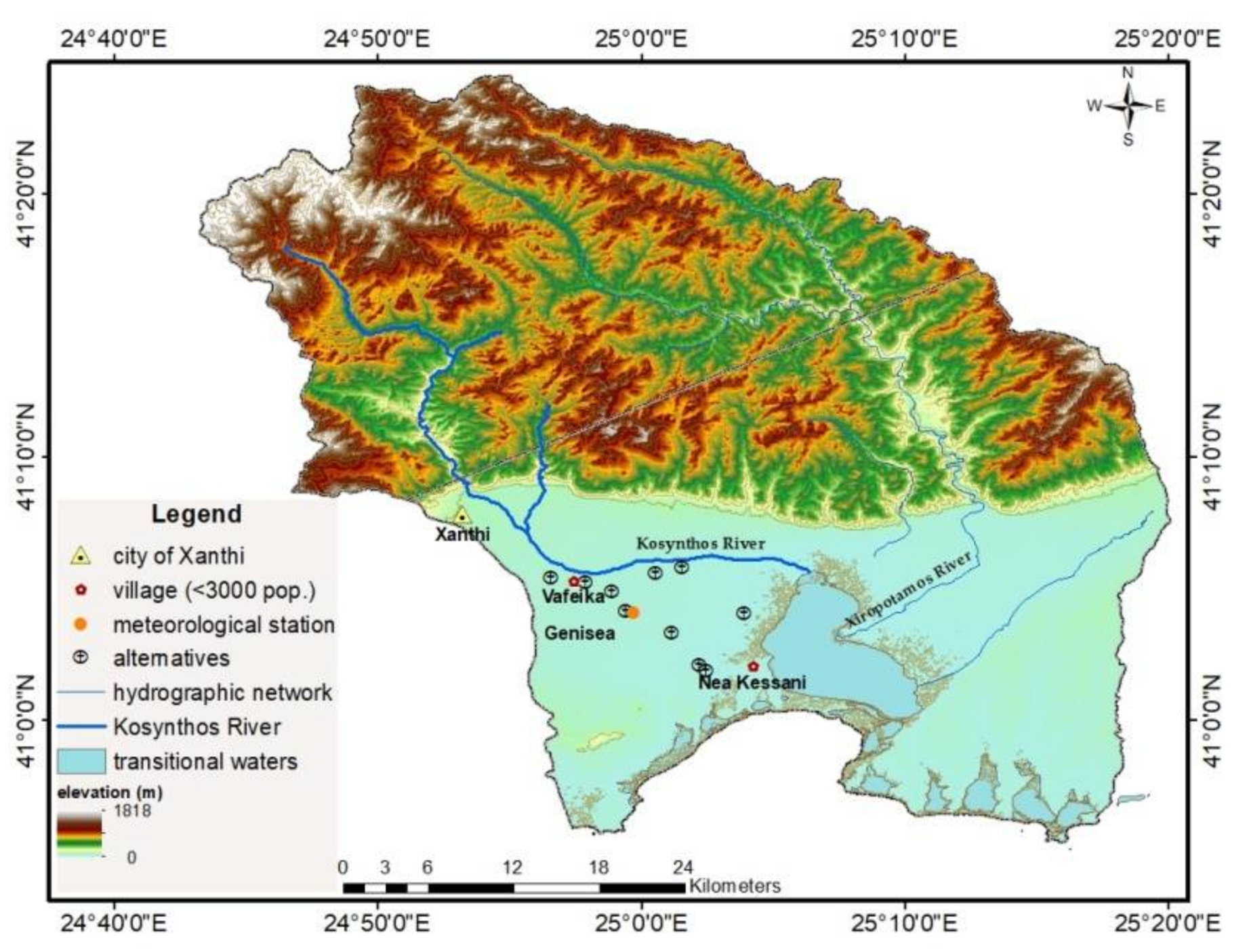
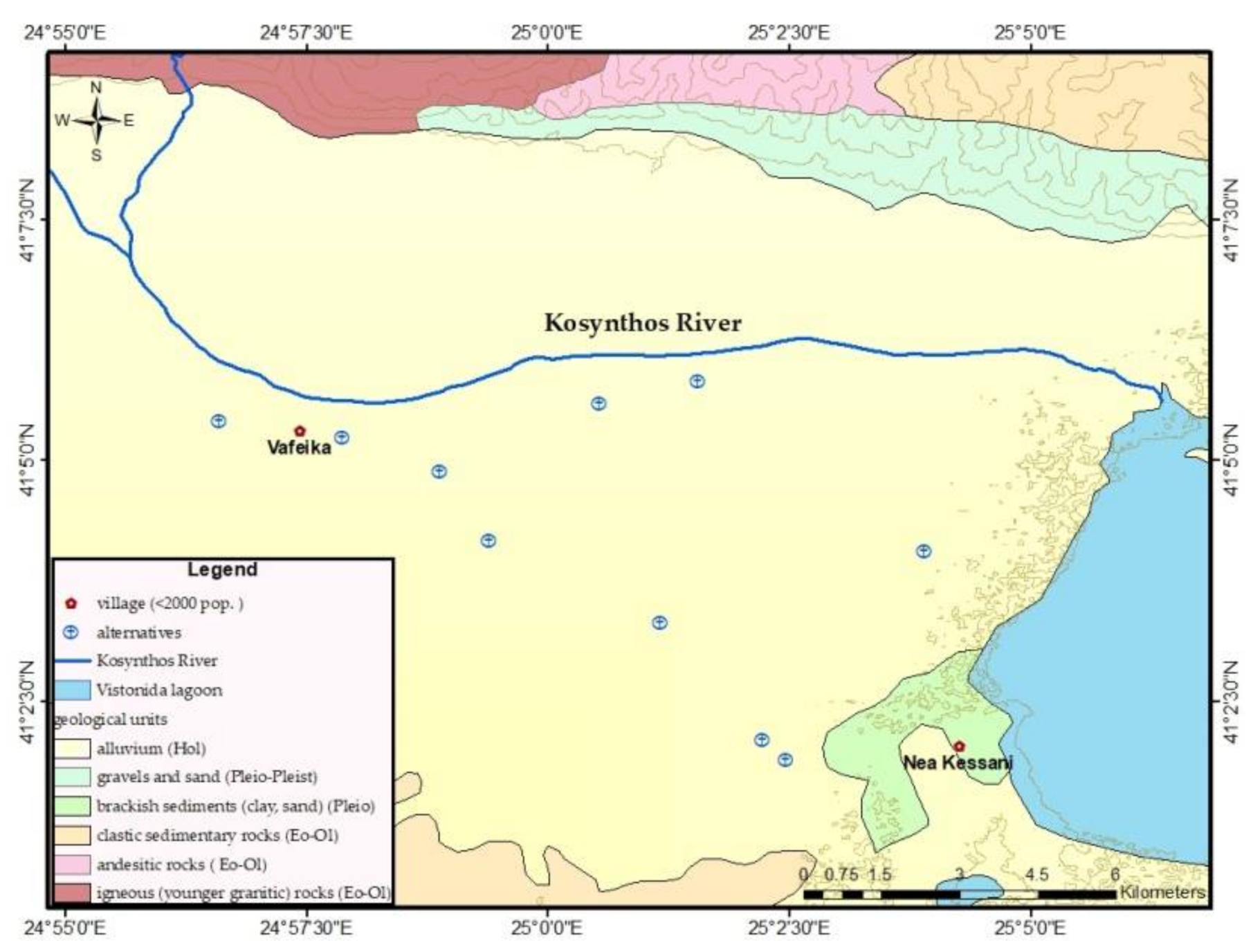
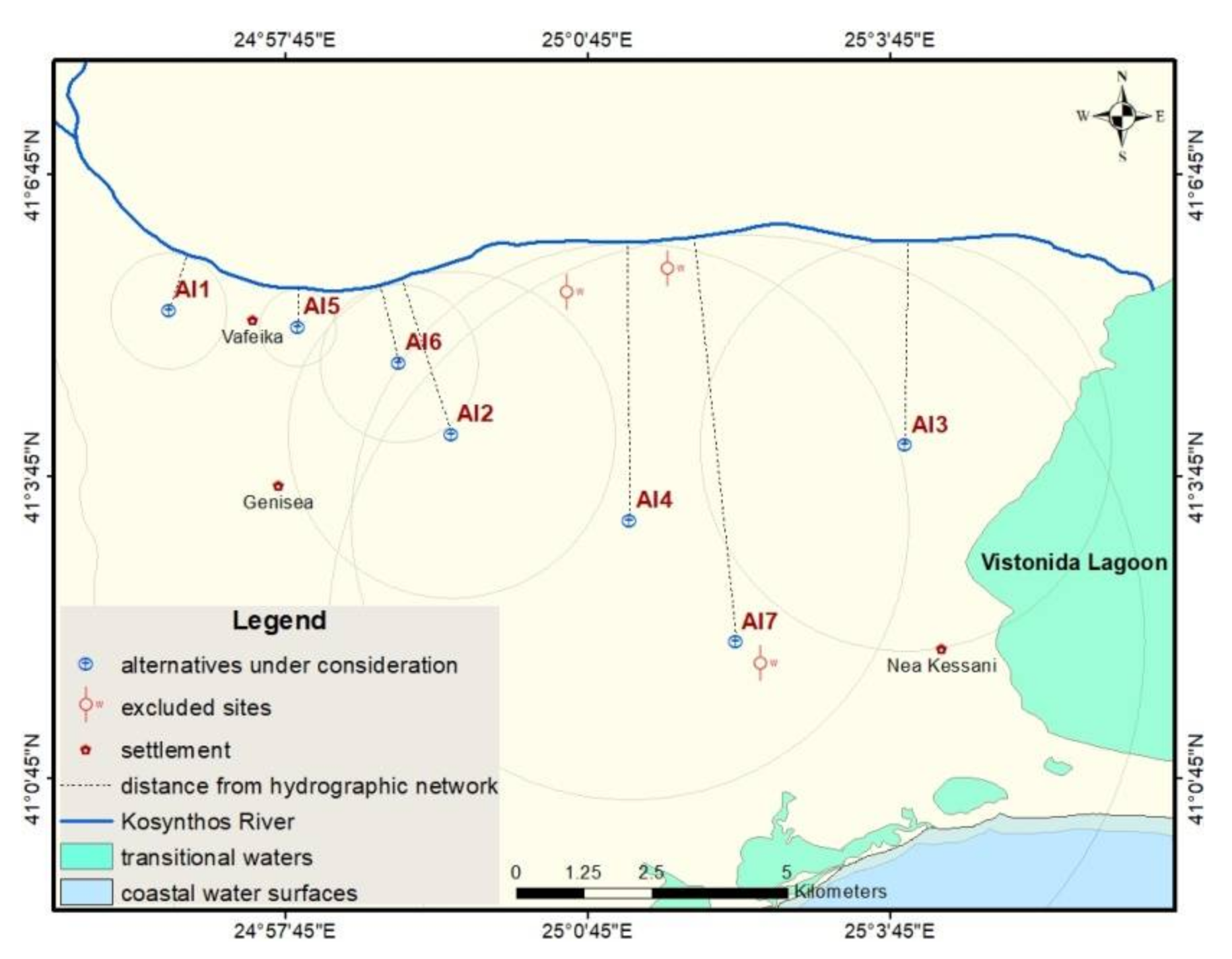
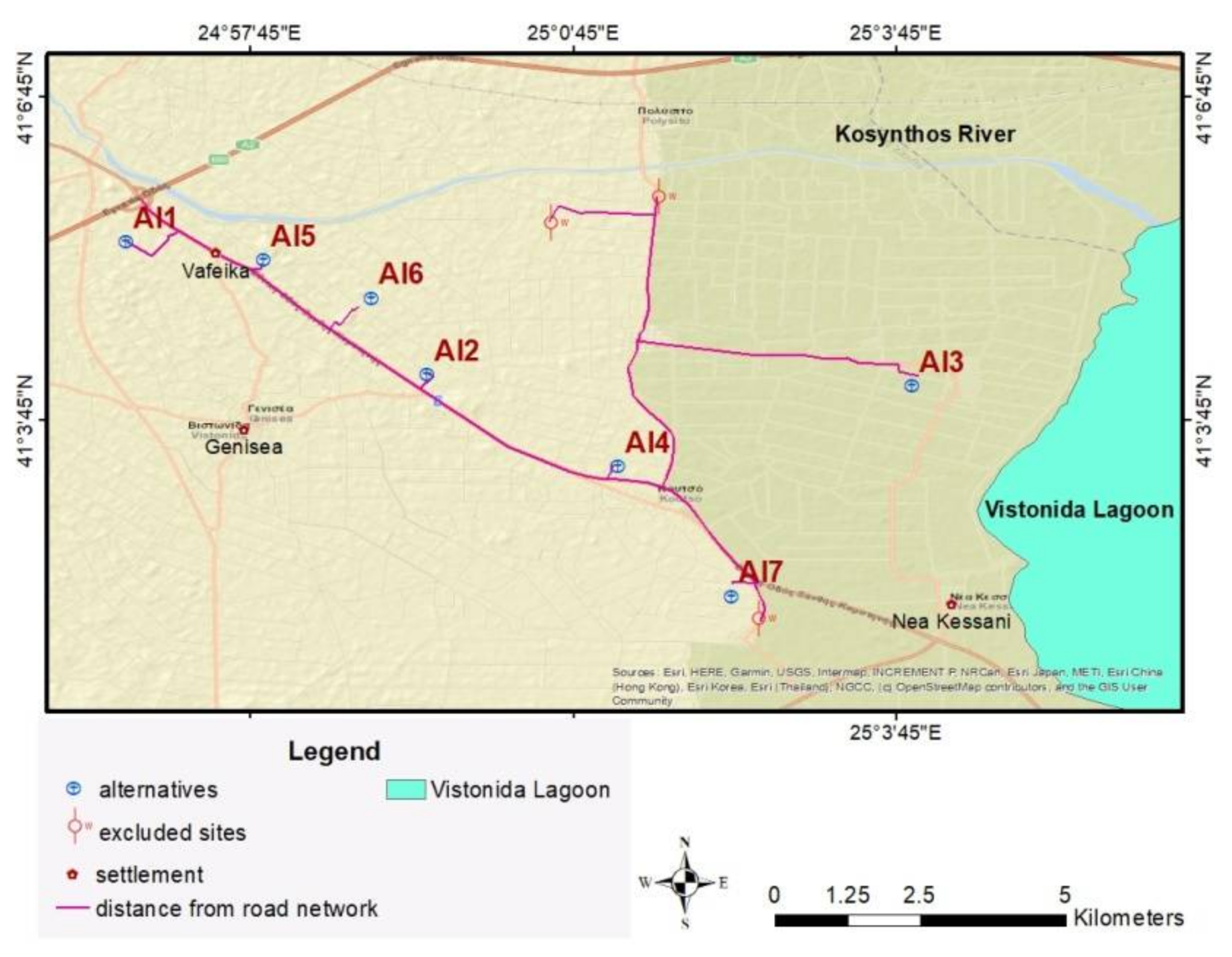
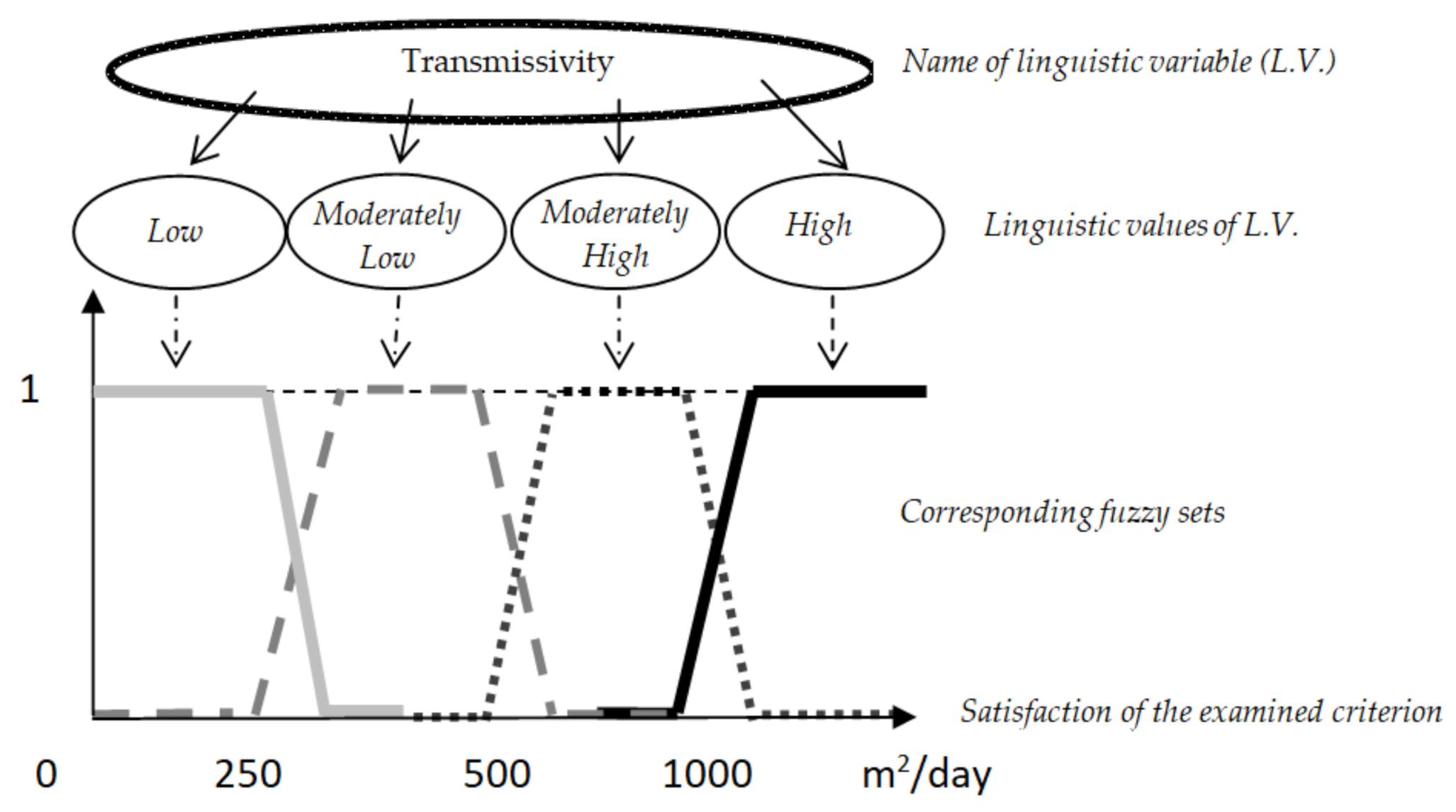
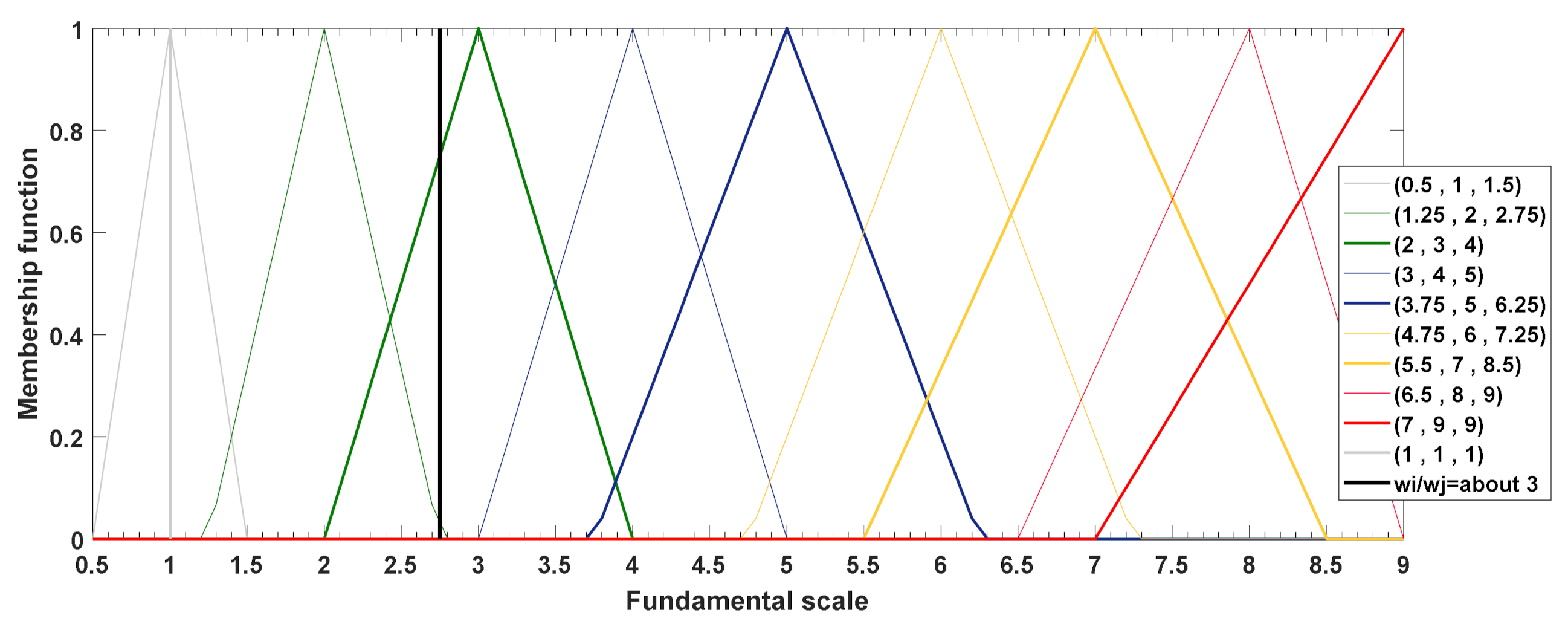
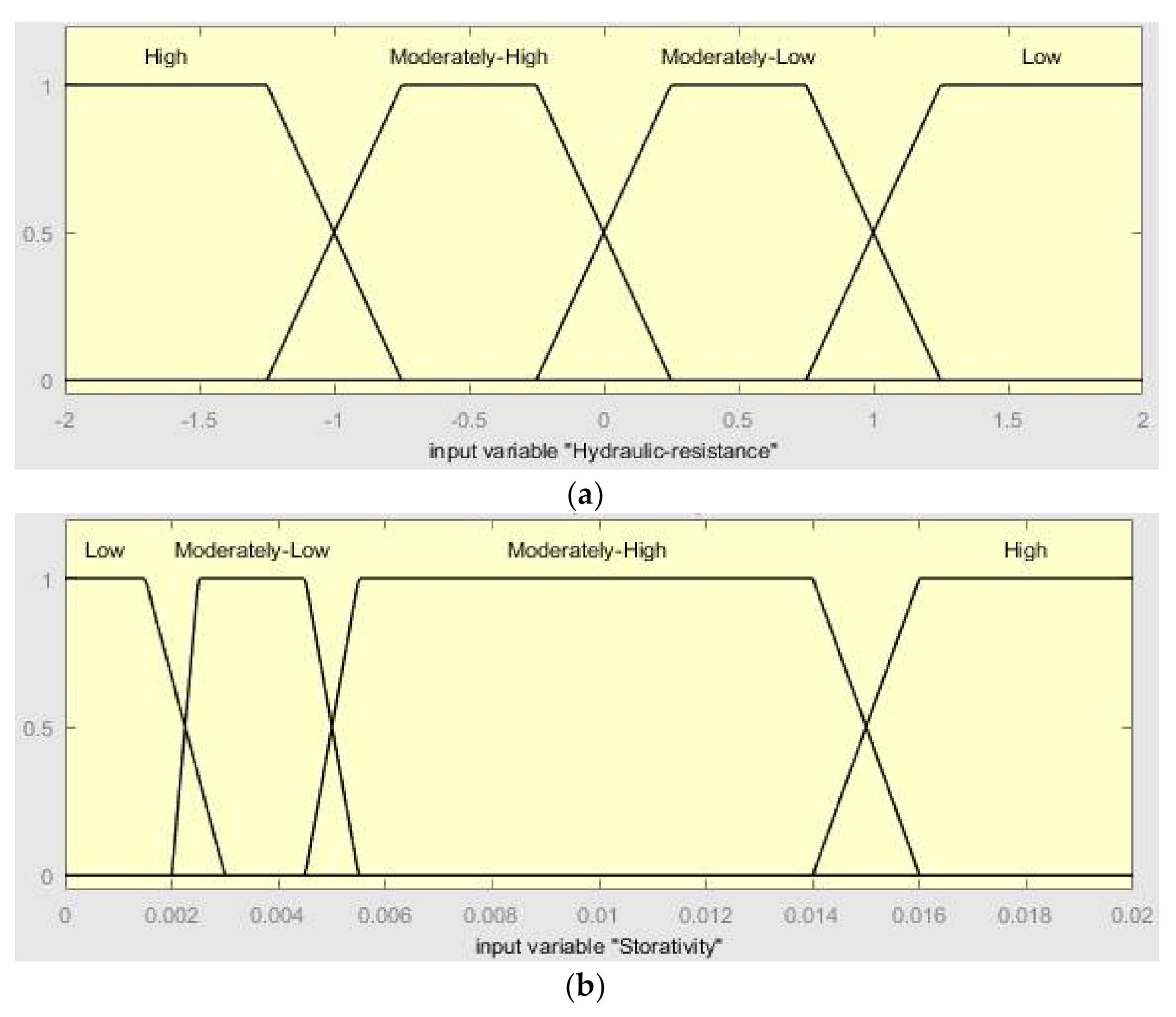
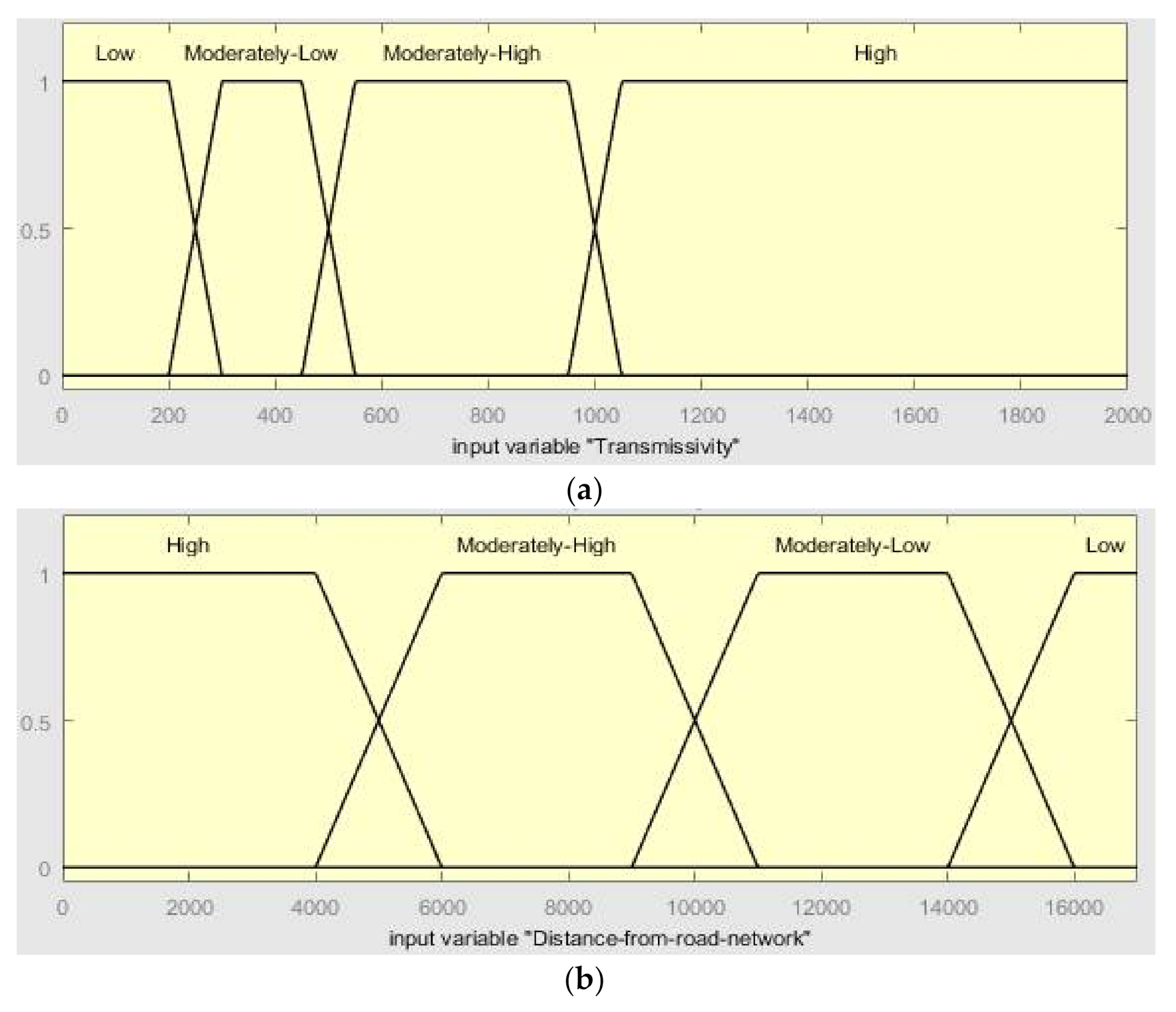
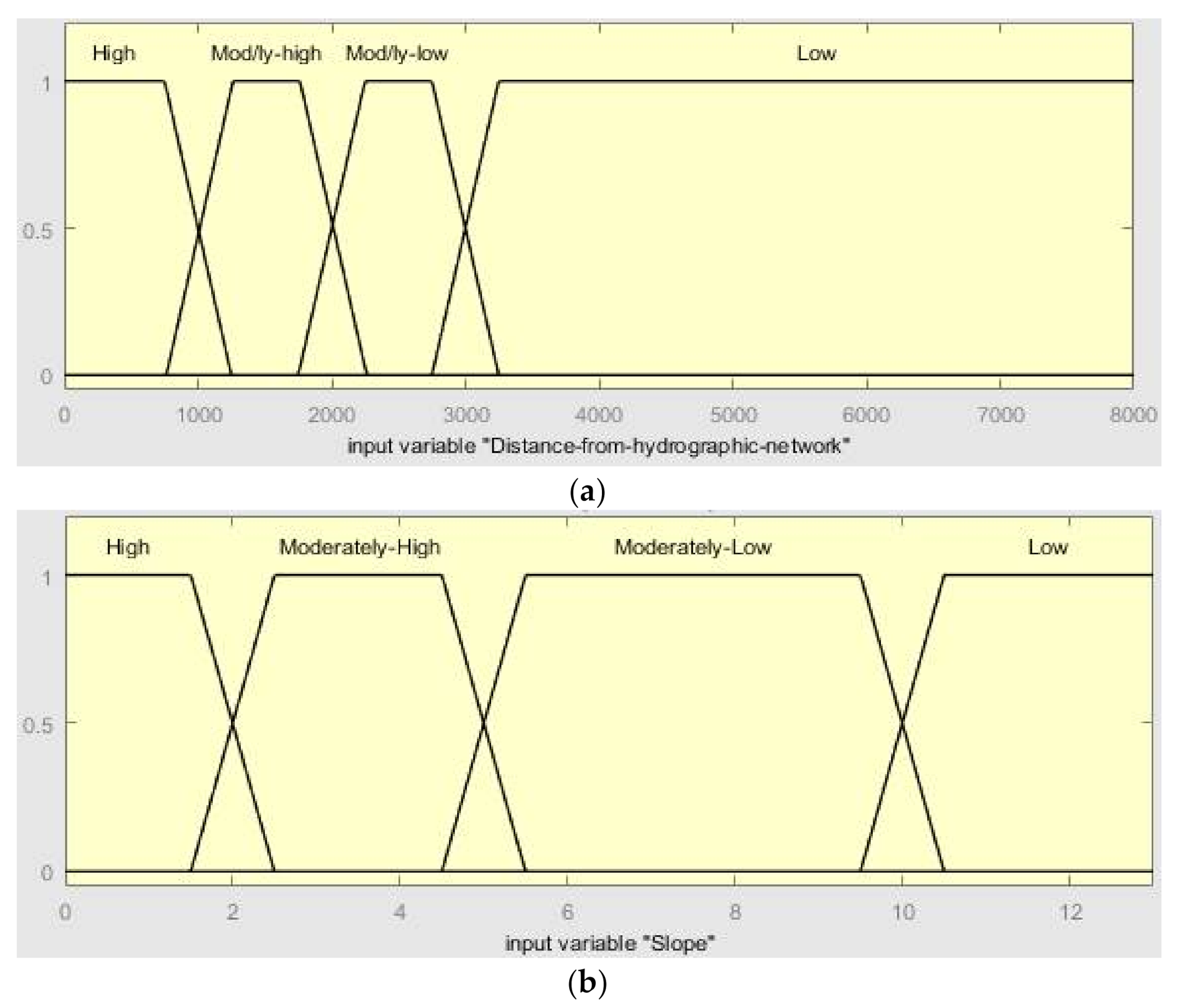
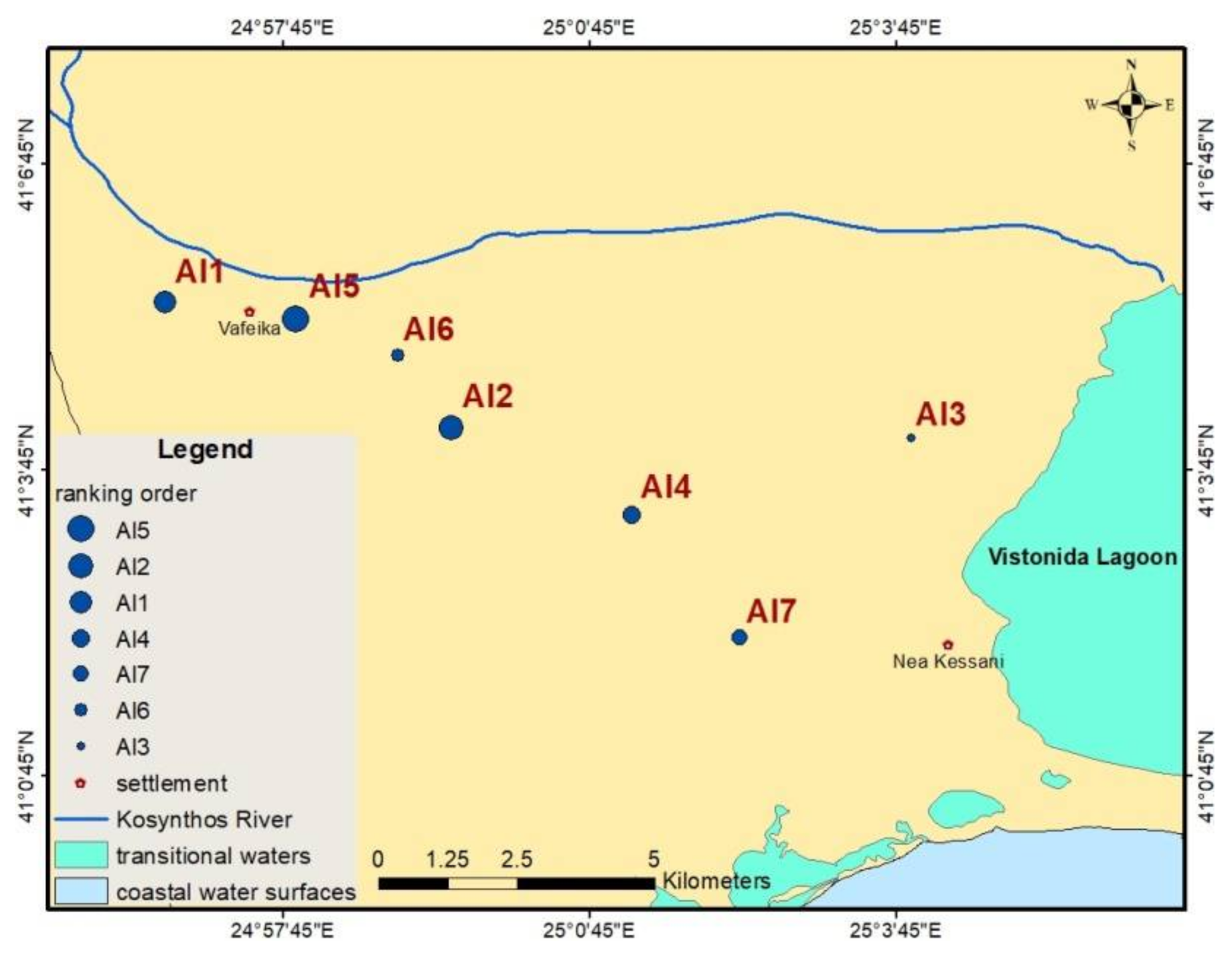
Publisher’s Note: MDPI stays neutral with regard to jurisdictional claims in published maps and institutional affiliations. |
© 2022 by the authors. Licensee MDPI, Basel, Switzerland. This article is an open access article distributed under the terms and conditions of the Creative Commons Attribution (CC BY) license (https://creativecommons.org/licenses/by/4.0/).
Share and Cite
Papadopoulos, C.; Spiliotis, M.; Pliakas, F.; Gkiougkis, I.; Kazakis, N.; Papadopoulos, B. Hybrid Fuzzy Multi-Criteria Analysis for Selecting Discrete Preferable Groundwater Recharge Sites. Water 2022, 14, 107. https://doi.org/10.3390/w14010107
Papadopoulos C, Spiliotis M, Pliakas F, Gkiougkis I, Kazakis N, Papadopoulos B. Hybrid Fuzzy Multi-Criteria Analysis for Selecting Discrete Preferable Groundwater Recharge Sites. Water. 2022; 14(1):107. https://doi.org/10.3390/w14010107
Chicago/Turabian StylePapadopoulos, Christopher, Mike Spiliotis, Fotios Pliakas, Ioannis Gkiougkis, Nerantzis Kazakis, and Basil Papadopoulos. 2022. "Hybrid Fuzzy Multi-Criteria Analysis for Selecting Discrete Preferable Groundwater Recharge Sites" Water 14, no. 1: 107. https://doi.org/10.3390/w14010107
APA StylePapadopoulos, C., Spiliotis, M., Pliakas, F., Gkiougkis, I., Kazakis, N., & Papadopoulos, B. (2022). Hybrid Fuzzy Multi-Criteria Analysis for Selecting Discrete Preferable Groundwater Recharge Sites. Water, 14(1), 107. https://doi.org/10.3390/w14010107









